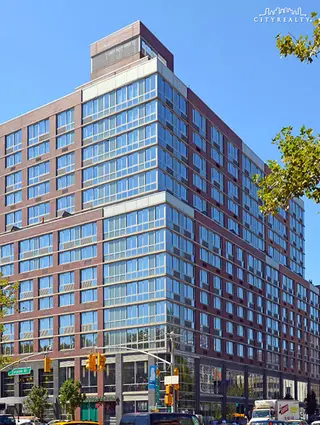 Carter Horsley
Carter HorsleyDec 23, 2011
Carter's Review
The Chrystie is a 14-story rental apartment building with 361 units at 229 Chrystie Street between East Houston and Stanton Streets on the Lower East Side and was completed in 2005.
It was developed in the Cooper Square Urban Renewal site by AvalonBay Communities and designed by Arquitectonica and SLCE and was formerly known as Avalon Chrystie Place.
It was the first of four buildings with a total of 708 units across irregular parcels between East Second Street to the north and Stanton Street to the South, the Bowery to the west and Second Avenue and Chrystie Street to the east - “land that has been the target of fierce dissension and the site of failed plans for decades,” according to a January 4, 2004 article by Nadine Brozan in The New York Times.
Bottom Line
A large and attractive development of a prominent site that was undeveloped for many years at a prominent Lower East Side site on East Houston Street.
Description
The Chrysti has an 8-story-high wing on the southeast corner at The Bowery and a 14-story tower further east. The Bowery retail frontage is occupied by Whole Foods.
The two-story retail base has a light-colored stone façade while the rest of the building has a red-brick façade with discrete air-conditioners and metallic corner windows.
Amenities
The building has a doorman, a gym, a live-in superintendent, swimming pool, a residents’ lounge with a pool table, a roof deck and community facilities. It is pet-friendly.
Apartments
Penthouse 15 is a two-bedroom unit with a small entry across from an open, pass-through kitchen and a 20-foot-long living/dining room.
Apartment 433 is a two-bedroom unit with a 21-foot-long living/dining room with an open, pass-through kitchen.
Apartment 614 is a two-bedroom unit with an entry past an open, pass-through kitchen to a 20-foot-long living/dining room.
Apartment 728 is a studio unit with a 29-foot-long studio space with dining area and an enclosed kitchen.
Apartment 307 is a studio unit with a 15-foot-long living/dining area and an open, pass-through kitchen and a large terrace.
Apartment 632 is a studio unit with a living room that is 18-feet long with an angled wall and an enclosed kitchen.
History
A 2014 article in The New York Post by Lois Weiss reported that the Ashkenazy Acquisition Corp. had signed a contract to buy Chrystie Place for just under $400 million.
The article said that “we’ve learned the active acquirers, led by Ben Ashkenazy and Michael Alpert, are the winners of the sought-after retail and apartment complex at Houston and The Bowery that includes Whole Foods.”
The article said that at the time the 80/20 project was 95 percent occupied with 72 of those apartments paying affordable rents.
Ms. Brozan’s article noted that the site, “designated part of the Cooper Square Urban Renewal Area in 1970 by the City Board of Estimate,…had remained more or less untouched over the years, dotted by vacant lots and small, mostly unimproved, commercial and residential buildings.”
“AvalonBay evolved from two residential development concerns, Greenbriar Apartments Homes and a division of Trammel Crow, that were both founded in the early 1980s and later converted to REITSs,” her article continued, adding that “by 1994, these companies were known as Avalon Properties, based in Wilton, Conn, and Bay Apartment Communities, based in San Jose, Calif.” They merged in a $2 billion transaction in 1998.
The project preserved the Liz Christy Bowery-Houston Garden and positioned its buildings so as to not cast shadows on it.
In addition to having to erect the building over a subway tunnel, AvalonBay had to create a three-level community center with a gym a 75-foot-pool four classrooms and three meeting rooms for community organizations.
Designed by Arquitectonica and completed in 2005, the 361-unit 80/20 project at 229 Chrystie St. is 95 percent occupied, with 72 of those apartments paying affordable rents.
“But,’ the article continued, “sources said both the market-rate units and the 72,300 square-foot Whole Foods lease - which ends in 2028 - are now paying below market rents, and will thus provide ongoing rolling upside. The only two apartments for rent, for instance, are an alcove studio with a separate kitchen for more than $3,000 and a two-bedroom for $6,000 per month.
“This is the first foray into the apartment market for Ashkenazy, as it has until now concentrated on retail and office buildings such as the operating office leasehold at 635 Madison and the land under 625 Madison, as well as the Barney’s retail at 600 Madison.
“Ashkenazy has also purchased the retail at 1311 Lexington Ave. and in the base of 200 Central Park South.”
An August 13, 2008 article by Sewell Chan in The New York Times said that “the Justice Department filed a federal lawsuit in Manhattan against AvalonBay Communities…accusing the company of illegally discriminating against disabled people by failing to provide sufficient access to them.” It was the “government’s first lawsuit in Manhattan alleging violations of the Fair Housing Art in the design and construction of multifamily housing.” The complaint maintained that bathroom walls were not reinforced to permit the installation of grab bars and that kitchens and bathrooms were not usable by a person in a wheelchair. The article said that AvalonBay maintained that the development was erected in full compliance with Local Law 58, a statute that it said “has long been understood to satisfy the accessibility requirements of both federal and local law.”

- Rental built in 2005
- Located in Lower East Side
- 361 total apartments 361 total apartments
- Doorman
- Pets Allowed
 6sqft delivers the latest on real estate, architecture, and design, straight from New York City.
6sqft delivers the latest on real estate, architecture, and design, straight from New York City.
